LONDON—British scientists are building a database of hand images in order to track down child abusers and other criminals.
Experts from Lancaster University are asking the British public to send images of their hands so they can train artificial intelligence to spot criminals.




